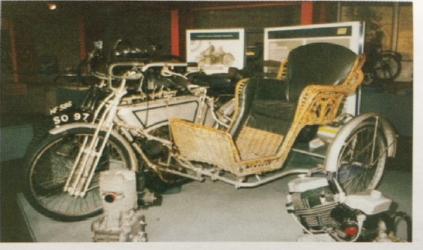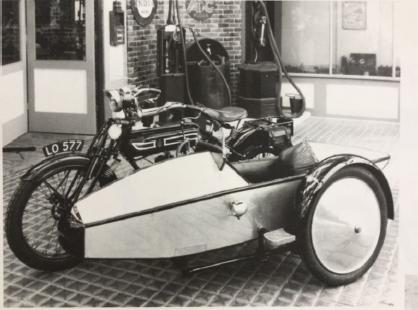
DID – U – KNOW
by Facia Nearside
 Siegfried Bettmann emigrated from Nuremberg Germany to Coventry England in 1883. One year later 20-year-old Bettmann formed his own company to produce bicycles. He named it the Triumph Cycle Company, hoping those were the results it would achieve. Bicycle production went well and by 1902 the company expanded to motorcycle production, which initially was nothing more than a bicycle with an engine attached. By 1907 Triumph was producing 1000 motorcycles per year. The machines used a single-cylinder four-stroke engine which proved to be very reliable, thus living up to the name “Trusty Triumph”. Siegfried Bettmann emigrated from Nuremberg Germany to Coventry England in 1883. One year later 20-year-old Bettmann formed his own company to produce bicycles. He named it the Triumph Cycle Company, hoping those were the results it would achieve. Bicycle production went well and by 1902 the company expanded to motorcycle production, which initially was nothing more than a bicycle with an engine attached. By 1907 Triumph was producing 1000 motorcycles per year. The machines used a single-cylinder four-stroke engine which proved to be very reliable, thus living up to the name “Trusty Triumph”.
| |


Typical Motorcycle sidecar from just after World War I
|
 The first World War was a boost for the company as these first modern motorcycles proved to be an important communication method for the British army. During the course of the war more than 30,000 motorcycles were supplied for the Allied effort. Many were ridden by soldiers who had little or no experience with motor vehicles of any type before the war. The first World War was a boost for the company as these first modern motorcycles proved to be an important communication method for the British army. During the course of the war more than 30,000 motorcycles were supplied for the Allied effort. Many were ridden by soldiers who had little or no experience with motor vehicles of any type before the war.
 Like many young men in England 22-year-old William Walmsley joined a cavalry regiment during the conflict. Born with a silver spoon he returned home at war’s end but did not need to earn a living because of his father’s substantial coal business. When he left the army Walmsley brought with him one of the surplus Triumph motorcycles, and found a pastime in restoring it. He must have been good at it because soon friends engaged him to restore and refurbish their motorcycles as well. As exciting as this was for a young man it was a rather uncomfortable and unromantic means of conveyance for two. Some resorted to putting their sweetheart into a trailer behind, but this was a rough and somewhat dangerous solution. Like many young men in England 22-year-old William Walmsley joined a cavalry regiment during the conflict. Born with a silver spoon he returned home at war’s end but did not need to earn a living because of his father’s substantial coal business. When he left the army Walmsley brought with him one of the surplus Triumph motorcycles, and found a pastime in restoring it. He must have been good at it because soon friends engaged him to restore and refurbish their motorcycles as well. As exciting as this was for a young man it was a rather uncomfortable and unromantic means of conveyance for two. Some resorted to putting their sweetheart into a trailer behind, but this was a rough and somewhat dangerous solution.

 W.J. Graham of Enfield England had invented the motorcycle sidecar in 1903. The device was little more than a large bulky wicker chair with a wheel on one side and the ability to be attached to a motorcycle. Walmsley was a gifted craftsman and he envisioned a much sturdier and fashionable solution. He designed a low cigar-like shape out of gleaming aluminum. It had a comfortable upholstered seat and a windscreen for passenger comfort. Walmsley called his invention “Ot-As-Ell” and he must not have been the only one who thought it so because soon requests were pouring in from other motorcycle enthusiasts. He began producing them in his garden shed at the rate of about one per week, his wife doing the trimming work. W.J. Graham of Enfield England had invented the motorcycle sidecar in 1903. The device was little more than a large bulky wicker chair with a wheel on one side and the ability to be attached to a motorcycle. Walmsley was a gifted craftsman and he envisioned a much sturdier and fashionable solution. He designed a low cigar-like shape out of gleaming aluminum. It had a comfortable upholstered seat and a windscreen for passenger comfort. Walmsley called his invention “Ot-As-Ell” and he must not have been the only one who thought it so because soon requests were pouring in from other motorcycle enthusiasts. He began producing them in his garden shed at the rate of about one per week, his wife doing the trimming work.
 In 1921 Walmsley’s father sold the coal business to George William Swallow. Birds of the same name are known for their lightness and agility, a similarity to his sidecars which was not lost upon young William. Indeed, Walmsley began using the name Swallow Sidecars for promotions about this time, so it seems likely that name was inspired by Mr. Swallow. The die had been cast for what one year later would officially become The Swallow Sidecar Company. In 1921 Walmsley’s father sold the coal business to George William Swallow. Birds of the same name are known for their lightness and agility, a similarity to his sidecars which was not lost upon young William. Indeed, Walmsley began using the name Swallow Sidecars for promotions about this time, so it seems likely that name was inspired by Mr. Swallow. The die had been cast for what one year later would officially become The Swallow Sidecar Company.
Editor Note: Article previously published in British Boots and Bonnets newsletter, March 2022
|